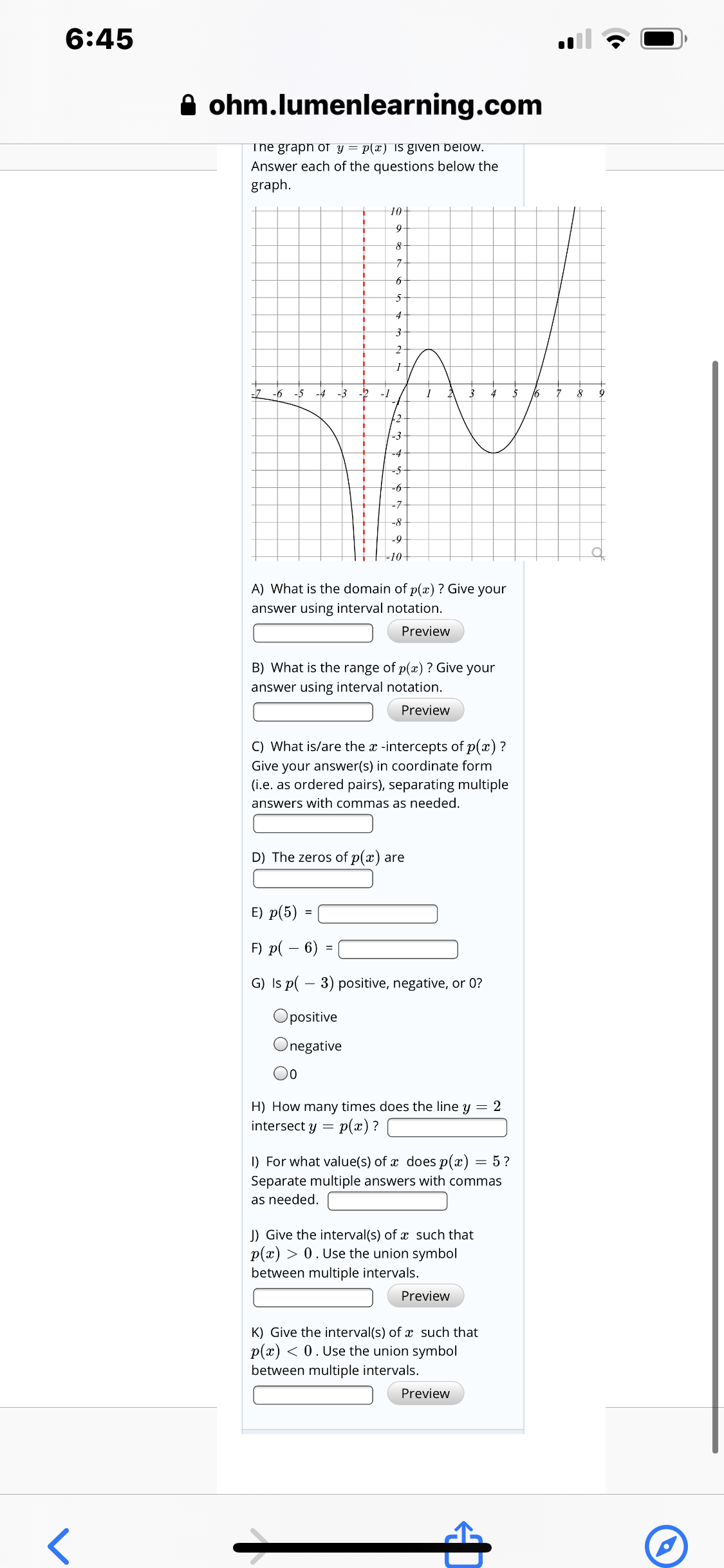6:45 A ohm.lumenlearning.com The graph of y = p(x) IS given below. Answer each of the questions below the graph. 10 5- -5 -4 -3 -1 16 +2 -3 -4 -6 -7- -8 -9 -10+ A) What is the domain of p(x) ? Give your answer using interval notation. Preview B) What is the range of p(æ) ? Give your answer using interval notation. Preview C) What is/are the x -intercepts of p(x) ? Give your answer(s) in coordinate form (i.e. as ordered pairs), separating multiple answers with commas as needed. D) The zeros of p(x) are E) p(5) = F) p( – 6) = G) Is p( – 3) positive, negative, or 0? Opositive Onegative 00 H) How many times does the line y = 2 p(x) ? intersect y = I) For what value(s) of x does p(x) = 5? Separate multiple answers with commas as needed. J) Give the interval(s) of x such that p(x) > 0. Use the union symbol between multiple intervals. Preview K) Give the interval(s) of x such that p(x) < 0. Use the union symbol between multiple intervals. Preview
6:45 A ohm.lumenlearning.com The graph of y = p(x) IS given below. Answer each of the questions below the graph. 10 5- -5 -4 -3 -1 16 +2 -3 -4 -6 -7- -8 -9 -10+ A) What is the domain of p(x) ? Give your answer using interval notation. Preview B) What is the range of p(æ) ? Give your answer using interval notation. Preview C) What is/are the x -intercepts of p(x) ? Give your answer(s) in coordinate form (i.e. as ordered pairs), separating multiple answers with commas as needed. D) The zeros of p(x) are E) p(5) = F) p( – 6) = G) Is p( – 3) positive, negative, or 0? Opositive Onegative 00 H) How many times does the line y = 2 p(x) ? intersect y = I) For what value(s) of x does p(x) = 5? Separate multiple answers with commas as needed. J) Give the interval(s) of x such that p(x) > 0. Use the union symbol between multiple intervals. Preview K) Give the interval(s) of x such that p(x) < 0. Use the union symbol between multiple intervals. Preview
Algebra & Trigonometry with Analytic Geometry
13th Edition
ISBN:9781133382119
Author:Swokowski
Publisher:Swokowski
Chapter5: Inverse, Exponential, And Logarithmic Functions
Section5.1: Inverse Functions
Problem 56E
Related questions
Question

Transcribed Image Text:6:45
A ohm.lumenlearning.com
The graph of y = p(x) IS given below.
Answer each of the questions below the
graph.
10
5-
-5 -4 -3
-1
16
+2
-3
-4
-6
-7-
-8
-9
-10+
A) What is the domain of p(x) ? Give your
answer using interval notation.
Preview
B) What is the range of p(æ) ? Give your
answer using interval notation.
Preview
C) What is/are the x -intercepts of p(x) ?
Give your answer(s) in coordinate form
(i.e. as ordered pairs), separating multiple
answers with commas as needed.
D) The zeros of p(x) are
E) p(5) =
F) p( – 6) =
G) Is p( – 3) positive, negative, or 0?
Opositive
Onegative
00
H) How many times does the line y = 2
p(x) ?
intersect y =
I) For what value(s) of x does p(x) = 5?
Separate multiple answers with commas
as needed.
J) Give the interval(s) of x such that
p(x) > 0. Use the union symbol
between multiple intervals.
Preview
K) Give the interval(s) of x such that
p(x) < 0. Use the union symbol
between multiple intervals.
Preview
Expert Solution
This question has been solved!
Explore an expertly crafted, step-by-step solution for a thorough understanding of key concepts.
This is a popular solution!
Trending now
This is a popular solution!
Step by step
Solved in 4 steps with 4 images

Recommended textbooks for you

Algebra & Trigonometry with Analytic Geometry
Algebra
ISBN:
9781133382119
Author:
Swokowski
Publisher:
Cengage

Algebra: Structure And Method, Book 1
Algebra
ISBN:
9780395977224
Author:
Richard G. Brown, Mary P. Dolciani, Robert H. Sorgenfrey, William L. Cole
Publisher:
McDougal Littell

Algebra & Trigonometry with Analytic Geometry
Algebra
ISBN:
9781133382119
Author:
Swokowski
Publisher:
Cengage

Algebra: Structure And Method, Book 1
Algebra
ISBN:
9780395977224
Author:
Richard G. Brown, Mary P. Dolciani, Robert H. Sorgenfrey, William L. Cole
Publisher:
McDougal Littell